
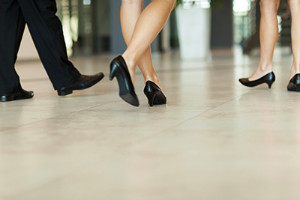 If you are standing or walking for the majority of the day as a result of your working activities, you may be familiar with the pain and discomfort your feet may experience. Specific foot conditions may amplify and become worse by standing on your feet for most of the day, including pain that may originate from corns, calluses, or certain foot deformities. There may be several options that can be enforced to alleviate a portion of the discomfort, which may include executing changes in the working environment, wearing different types of shoes or using shoe inserts, and standing on suitable floor mats instead of hard floors. Research has shown that moderate relief may be attained by performing simple foot stretches throughout the day. It may also help to elevate the feet when the work day is over, and this may aid in reducing any swelling that may be present. If you would like additional advice on how your feet may feel better while working, it’s suggested to speak with a podiatrist who will be able to provide the correct information.
If you are standing or walking for the majority of the day as a result of your working activities, you may be familiar with the pain and discomfort your feet may experience. Specific foot conditions may amplify and become worse by standing on your feet for most of the day, including pain that may originate from corns, calluses, or certain foot deformities. There may be several options that can be enforced to alleviate a portion of the discomfort, which may include executing changes in the working environment, wearing different types of shoes or using shoe inserts, and standing on suitable floor mats instead of hard floors. Research has shown that moderate relief may be attained by performing simple foot stretches throughout the day. It may also help to elevate the feet when the work day is over, and this may aid in reducing any swelling that may be present. If you would like additional advice on how your feet may feel better while working, it’s suggested to speak with a podiatrist who will be able to provide the correct information.
While working on the feet, it is important to take the proper care of them. For more information about working on your feet, contact Dr. Stephan J. LaPointe from Georgia Foot & Ankle Specialists . Our doctor will treat your foot and ankle needs.
Working on Your Feet
Standing on your feet for long periods of time can cause stress and pain in your feet. Your whole body may experience change in terms of posture, back pain, bunions, callouses and or plantar warts. There are ways to avoid these conditions with proper foot care, smart choices and correct posture.
Positive Changes
Negative heeled shoe – Choosing this shoe type places the heel slightly lower than the ball of the foot. These are great for overall foot health. Find shoes that fit you correctly.
Go barefoot – Our feet were not designed to be enclosed for all hours of the day. Try to periodically expose your feet to air.
Eliminate Pain
Foot Exercises – Performing simple exercises, incorporating yoga and doing stretches are beneficial. This will allow increased blood flow to the area and muscles of the foot.
Achilles tendon – Stretching the foot out flat on the floor will relax the calf muscles and tendon. These exercises can be performed almost anywhere. Make sure you add these exercises to your daily regimen.
With a little bit of this information and knowing more about foot health, you will notice changes. Foot stretches and proper footwear will help with pain and prevent further issues.
If you have any questions please feel free to contact our office located in Rome, GA . We offer the newest diagnostic and treatment technologies for all your foot and ankle needs.
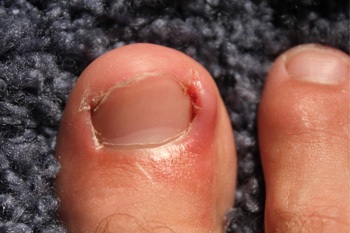 If you are experiencing pain and swelling surrounding the nail on the big toe, you may have what is known as an ingrown toenail. Research has shown that when this condition is treated promptly and correctly, many unpleasant and uncomfortable foot conditions may be avoided. These may include a painful infection developing, as well as partial or total removal of the toenail. There are several causes of why this ailment may occur, including improperly cut toenails, wearing shoes and socks that may be too tight, or possible injuries to the toe. Additionally, genetics may play a role in determining the shape of the toenail, which may press more easily into the side of the toenail. Painful symptoms may include bleeding or discharge from the surrounding area of the toenail, severe redness, or swelling. It’s advised to consult with a podiatrist as quickly as possible so the correct treatment options may be discussed.
If you are experiencing pain and swelling surrounding the nail on the big toe, you may have what is known as an ingrown toenail. Research has shown that when this condition is treated promptly and correctly, many unpleasant and uncomfortable foot conditions may be avoided. These may include a painful infection developing, as well as partial or total removal of the toenail. There are several causes of why this ailment may occur, including improperly cut toenails, wearing shoes and socks that may be too tight, or possible injuries to the toe. Additionally, genetics may play a role in determining the shape of the toenail, which may press more easily into the side of the toenail. Painful symptoms may include bleeding or discharge from the surrounding area of the toenail, severe redness, or swelling. It’s advised to consult with a podiatrist as quickly as possible so the correct treatment options may be discussed.
Ingrown toenails can become painful if they are not treated properly. For more information about ingrown toenails, contact Dr. Stephan J. LaPointe of Georgia Foot & Ankle Specialists . Our doctor can provide the care you need to keep you pain-free and on your feet.
Ingrown Toenails
Ingrown toenails occur when a toenail grows sideways into the bed of the nail, causing pain, swelling, and possibly infection.
Causes
Prevention
Because ingrown toenails are not something found outside of shoe-wearing cultures, going barefoot as often as possible will decrease the likeliness of developing ingrown toenails. Wearing proper fitting shoes and using proper cutting techniques will also help decrease your risk of developing ingrown toenails.
Treatment
Ingrown toenails are a very treatable foot condition. In minor cases, soaking the affected area in salt or antibacterial soaps will not only help with the ingrown nail itself, but also help prevent any infections from occurring. In more severe cases, surgery is an option. In either case, speaking to your podiatrist about this condition will help you get a better understanding of specific treatment options that are right for you.
If you have any questions please feel free to contact our office located in Rome, GA . We offer the newest diagnostic and treatment technologies for all your foot and ankle needs.
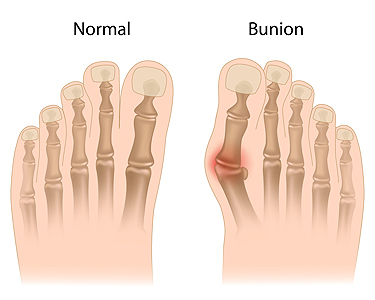 The medical condition known as hallux valgus is commonly referred to as a bunion. It typically occurs as a result of a misalignment in the joint of the big toe, and may cause pain and discomfort. It appears as a large bony protrusion on the side of the big toe and may be difficult to wear specific shoes. If you have a bunion, you most likely may notice tenderness and swelling around the affected joint, in addition to possible joint pain arising from the development of arthritis. This may develop at a faster rate if the bunion is not treated promptly. Some of the reasons why bunions could form may include having an abnormal foot structure such as flat feet, an inherited genetic trait, or extremely flexible ligaments and tendons. Research has shown there are different treatment techniques, which may provide moderate relief. This includes wearing shoes that fit correctly, performing gentle exercises, or wearing insoles in the shoes. It’s important to consult with a podiatrist who can determine the best treatment option for you.
The medical condition known as hallux valgus is commonly referred to as a bunion. It typically occurs as a result of a misalignment in the joint of the big toe, and may cause pain and discomfort. It appears as a large bony protrusion on the side of the big toe and may be difficult to wear specific shoes. If you have a bunion, you most likely may notice tenderness and swelling around the affected joint, in addition to possible joint pain arising from the development of arthritis. This may develop at a faster rate if the bunion is not treated promptly. Some of the reasons why bunions could form may include having an abnormal foot structure such as flat feet, an inherited genetic trait, or extremely flexible ligaments and tendons. Research has shown there are different treatment techniques, which may provide moderate relief. This includes wearing shoes that fit correctly, performing gentle exercises, or wearing insoles in the shoes. It’s important to consult with a podiatrist who can determine the best treatment option for you.
If you are suffering from bunions, contact Dr. Stephan J. LaPointe of Georgia Foot & Ankle Specialists . Our doctor can provide the care you need to keep you pain-free and on your feet.
What Is a Bunion?
A bunion is formed of swollen tissue or an enlargement of boney growth, usually located at the base joint of the toe that connects to the foot. The swelling occurs due to the bones in the big toe shifting inward, which impacts the other toes of the foot. This causes the area around the base of the big toe to become inflamed and painful.
Why Do Bunions Form?
Genetics – Susceptibility to bunions are often hereditary
Stress on the feet – Poorly fitted and uncomfortable footwear that places stress on feet, such as heels, can worsen existing bunions
How Are Bunions Diagnosed?
Doctors often perform two tests – blood tests and x-rays – when trying to diagnose bunions, especially in the early stages of development. Blood tests help determine if the foot pain is being caused by something else, such as arthritis, while x-rays provide a clear picture of your bone structure to your doctor.
How Are Bunions Treated?
If you have any questions, please feel free to contact our office located in Rome, GA . We offer the newest diagnostic and treatment technologies for all your foot care needs.
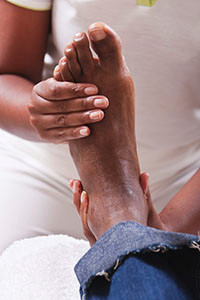 If we should incur an injury to the foot or ankle, it may affect the quality of completing daily activities efficiently. As a result, having physical therapy performed may be an effective channel that promotes healing in addition to bringing gradual and moderate relief. There are several foot conditions that may benefit from physical therapy, including stress fractures that involve the foot or ankle, the painful ailment known as plantar fasciitis, or turf toe, which is a sprain the big toe endures. Research has shown the multitude of benefits that physical therapy may provide including renewed and increased muscle strength, the ability to walk easier as the pain diminishes, or the added range of motion to the affected joints. If you have endured a severe injury to your foot or ankle, it’s suggested to speak with a podiatrist about whether physical therapy is correct for you.
If we should incur an injury to the foot or ankle, it may affect the quality of completing daily activities efficiently. As a result, having physical therapy performed may be an effective channel that promotes healing in addition to bringing gradual and moderate relief. There are several foot conditions that may benefit from physical therapy, including stress fractures that involve the foot or ankle, the painful ailment known as plantar fasciitis, or turf toe, which is a sprain the big toe endures. Research has shown the multitude of benefits that physical therapy may provide including renewed and increased muscle strength, the ability to walk easier as the pain diminishes, or the added range of motion to the affected joints. If you have endured a severe injury to your foot or ankle, it’s suggested to speak with a podiatrist about whether physical therapy is correct for you.
Foot therapy is often necessary for those recovering from either foot deformities or foot injuries. If you have concerns regarding therapy, consult with Dr. Stephan J. LaPointe from Georgia Foot & Ankle Specialists . Our doctor can provide the care you need to keep you pain-free and on your feet.
Most Common Injuries
People who are active or athletes are prone to a variety of injuries. Therefore, it is often important to take part in physical therapy in order to quickly get back on the right track.
What to Do When Injured
Physical Therapy – This specialized treatment will focus on the affected area, speeding up recovery and the overall healing process. It is a proven method that has helped millions of people return from any injury.
During physical therapy you will undergo regimented training to get back into full form. Training is often very difficult, especially at first when the foot feels weak. Physical therapy often involves:
Basic stretching and twisting exercises – getting the feet’s mobility and flexibility up.
Massaging – the therapist will massage the injured area in order to activate the muscles and relax them.
Strengthening Exercises – this allows the muscles in the affected area to regain their full strength, a vital step towards full recovery.
If you have any questions please feel free to contact our office located in Rome, GA . We offer the newest diagnostic tools and technology to treat your foot and ankle needs.
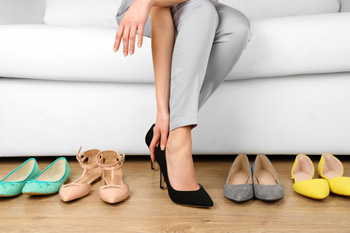 Despite the fact that many women enjoy wearing high heels, they may want to be aware of the potential damage wearing these types of shoes may cause. The toes may endure increased pressure, and this may specifically occur under the big toe. If you are susceptible to bunions, this may result in the formation of one, in addition to the development of corns and calluses, which may typically form on the balls of the feet or on top of the toes. Pain affecting the heel of the foot may be related to a condition known as plantar fasciitis. This may occur when the band of tissue on the bottom of the foot that connects the heel to the toes becomes inflamed, and severe pain and discomfort may often accompany this condition. Research has shown that regardless of the ailments that may develop as a result of wearing high heels, a large percentage of women choose to wear this type of shoe.
Despite the fact that many women enjoy wearing high heels, they may want to be aware of the potential damage wearing these types of shoes may cause. The toes may endure increased pressure, and this may specifically occur under the big toe. If you are susceptible to bunions, this may result in the formation of one, in addition to the development of corns and calluses, which may typically form on the balls of the feet or on top of the toes. Pain affecting the heel of the foot may be related to a condition known as plantar fasciitis. This may occur when the band of tissue on the bottom of the foot that connects the heel to the toes becomes inflamed, and severe pain and discomfort may often accompany this condition. Research has shown that regardless of the ailments that may develop as a result of wearing high heels, a large percentage of women choose to wear this type of shoe.
High heels have a history of causing foot and ankle problems. If you have any concerns about your feet or ankles, contact Dr. Stephan J. LaPointe from Georgia Foot & Ankle Specialists . Our doctor can provide the care you need to keep you pain-free and on your feet.
Effects of High Heels on the Feet
High heels are popular shoes among women because of their many styles and societal appeal. Despite this, high heels can still cause many health problems if worn too frequently.
Which Parts of My Body Will Be Affected by High Heels?
What Kinds of Foot Problems Can Develop from Wearing High Heels?
How Can I Still Wear High Heels and Maintain Foot Health?
If you want to wear high heeled shoes, make sure that you are not wearing them every day, as this will help prevent long term physical problems. Try wearing thicker heels as opposed to stilettos to distribute weight more evenly across the feet. Always make sure you are wearing the proper shoes for the right occasion, such as sneakers for exercising. If you walk to work, try carrying your heels with you and changing into them once you arrive at work. Adding inserts to your heels can help cushion your feet and absorb shock. Full foot inserts or metatarsal pads are available.
If you have any questions please feel free to contact our office located in Rome, GA . We offer the newest diagnostic and treatment technologies for all your foot and ankle needs.
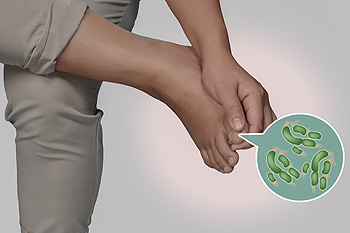 The uncomfortable condition that is known as athlete’s foot may typically have noticeable symptoms, which may include red and itchy skin. This may develop in between the toes or on the sole of the foot and is known to be a common fungal infection. This contagious foot ailment can be spread by direct contact with another person or from walking on wet floors, including shower and pool areas. There may be several preventative measures that can be practiced, which may avoid the onset of athlete’s foot. These may include washing and drying the feet thoroughly, changing socks promptly if they become wet, and wearing shoes that are made of breathable materials. If you feel you have contracted athlete’s foot, it’s advised to consult with a podiatrist who can suggest the best course of treatment that will provide relief.
The uncomfortable condition that is known as athlete’s foot may typically have noticeable symptoms, which may include red and itchy skin. This may develop in between the toes or on the sole of the foot and is known to be a common fungal infection. This contagious foot ailment can be spread by direct contact with another person or from walking on wet floors, including shower and pool areas. There may be several preventative measures that can be practiced, which may avoid the onset of athlete’s foot. These may include washing and drying the feet thoroughly, changing socks promptly if they become wet, and wearing shoes that are made of breathable materials. If you feel you have contracted athlete’s foot, it’s advised to consult with a podiatrist who can suggest the best course of treatment that will provide relief.
Athlete’s foot is an inconvenient condition that can be easily reduced with the proper treatment. If you have any concerns about your feet and ankles, contact Dr. Stephan J. LaPointe from Georgia Foot & Ankle Specialists . Our doctor will treat your foot and ankle needs.
Athlete’s Foot: The Sole Story
Athlete's foot, also known as tinea pedis, can be an extremely contagious foot infection. It is commonly contracted in public changing areas and bathrooms, dormitory style living quarters, around locker rooms and public swimming pools, or anywhere your feet often come into contact with other people.
Solutions to Combat Athlete’s Foot
Athlete’s foot can cause many irritating symptoms such as dry and flaking skin, itching, and redness. Some more severe symptoms can include bleeding and cracked skin, intense itching and burning, and even pain when walking. In the worst cases, Athlete’s foot can cause blistering as well. Speak to your podiatrist for a better understanding of the different causes of Athlete’s foot, as well as help in determining which treatment options are best for you.
If you have any questions please feel free to contact our office located in Rome, GA . We offer the newest diagnostic and treatment technologies for all your foot and ankle needs.
 Many people are aware of the discomfort that is typically associated with blisters on the feet. A blister affects the skin on the feet, and the body’s natural response to injured skin will often result in forming a bubble of fluid over the affected area. This will protect the skin from additional damage or infection that may occur. The most common reason for blisters to develop may be wearing shoes that do not fit properly and this may cause friction as the shoes rub against the skin. Additionally, blisters may develop if you are exposed to extremely cold temperatures, which may cause frostbite to occur. Blisters may also form as a result of a harsh sunburn, or an allergic reaction to an insect bite. Treatment may generally include using a gauze covering for protection, while wearing shoes, followed by fresh air exposure when the shoes are removed, which may accelerate the healing process. It is suggested to seek the counsel of a podiatrist to learn about additional treatment options for blisters.
Many people are aware of the discomfort that is typically associated with blisters on the feet. A blister affects the skin on the feet, and the body’s natural response to injured skin will often result in forming a bubble of fluid over the affected area. This will protect the skin from additional damage or infection that may occur. The most common reason for blisters to develop may be wearing shoes that do not fit properly and this may cause friction as the shoes rub against the skin. Additionally, blisters may develop if you are exposed to extremely cold temperatures, which may cause frostbite to occur. Blisters may also form as a result of a harsh sunburn, or an allergic reaction to an insect bite. Treatment may generally include using a gauze covering for protection, while wearing shoes, followed by fresh air exposure when the shoes are removed, which may accelerate the healing process. It is suggested to seek the counsel of a podiatrist to learn about additional treatment options for blisters.
Blisters are prone to making everyday activities extremely uncomfortable. If your feet are hurting, contact Dr. Stephan J. LaPointe of Georgia Foot & Ankle Specialists . Our doctor can provide the care you need to keep you pain-free and on your feet.
Foot Blisters
Foot blisters develop as a result of constantly wearing tight or ill-fitting footwear. This happens due to the constant rubbing from the shoe, which can often lead to pain.
What Are Foot Blisters?
A foot blister is a small fluid-filled pocket that forms on the upper-most layer of the skin. Blisters are filled with clear fluid and can lead to blood drainage or pus if the area becomes infected.
How Do Blisters Form?
Blisters on the feet are often the result of constant friction of skin and material, usually by shoe rubbing. Walking in sandals, boots, or shoes that don’t fit properly for long periods of time can result in a blister. Having consistent foot moisture and humidity can easily lead to blister formation.
Prevention & Treatment
It is important to properly care for the affected area in order to prevent infection and ease the pain. Do not lance the blister and use a Band-Aid to provide pain relief. Also, be sure to keep your feet dry and wear proper fitting shoes. If you see blood or pus in a blister, seek assistance from a podiatrist.
If you have any questions, please feel free to contact our office located in Rome, GA . We offer the newest diagnostic and treatment technologies for all your foot care needs.
 The condition known as rheumatoid arthritis is a painful ailment that typically affects the muscles and joints. When this occurs in the feet, the toenails may become affected in addition to the patient possibly experiencing pain and stiffness. The discomfort is generally felt in the smaller joints in the feet, and this can possibly lead to the formation of corns and bunions. In severe cases, the toes may curl and hammertoe may develop as a result of this. This particular form of arthritis occurs when the body’s immune system is compromised. The ability to fight infection is diminished, and this may cause pain and swelling to gradually develop. If you are afflicted with rheumatoid arthritis in the joints of the feet, it’s strongly suggested that you consult with a podiatrist, so correct treatment can commence.
The condition known as rheumatoid arthritis is a painful ailment that typically affects the muscles and joints. When this occurs in the feet, the toenails may become affected in addition to the patient possibly experiencing pain and stiffness. The discomfort is generally felt in the smaller joints in the feet, and this can possibly lead to the formation of corns and bunions. In severe cases, the toes may curl and hammertoe may develop as a result of this. This particular form of arthritis occurs when the body’s immune system is compromised. The ability to fight infection is diminished, and this may cause pain and swelling to gradually develop. If you are afflicted with rheumatoid arthritis in the joints of the feet, it’s strongly suggested that you consult with a podiatrist, so correct treatment can commence.
Because RA affects more than just your joints, including the joints in your feet and ankles, it is important to seek early diagnosis from your podiatrist if you feel like the pain in your feet might be caused by RA. For more information, contact Dr. Stephan J. LaPointe of Georgia Foot & Ankle Specialists . Our doctor will assist you with all of your podiatric concerns.
What Is Rheumatoid Arthritis?
Rheumatoid Arthritis (RA) is an autoimmune disorder in which the body’s own immune system attacks the membranes surrounding the joints. Inflammation of the lining and eventually the destruction of the joint’s cartilage and bone occur, causing severe pain and immobility.
Rheumatoid Arthritis of the Feet
Although RA usually attacks multiple bones and joints throughout the entire body, almost 90 percent of cases result in pain in the foot or ankle area.
Symptoms
Diagnosis
Quick diagnosis of RA in the feet is important so that the podiatrist can treat the area effectively. Your doctor will ask you about your medical history, occupation, and lifestyle to determine the origin of the condition. Rheumatoid Factor tests help to determine if someone is affected by the disease.
If you have any questions please feel free to contact our office located in Rome, GA . We offer the newest diagnostic and treatment technologies for all your foot and ankle needs.
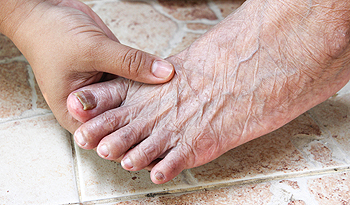 A condition that is referred to as onychomycosis is commonly known as a fungal infection of the toenails. It is common among people who have sweaty feet or enjoy spending time swimming. It may occur as a result of the small fungi seeping through tiny cuts in the skin, or possibly lodging between the nail and the nail bed. It may be common to find this type of infection in the toenails because of the warm environment the shoes and socks provide. There are several symptoms associated with this condition, including having a yellow, white or brown appearance, the nail becoming brittle and breaking easily, or the nail becomes uncomfortable. Despite the unsightly appearance, they typically do not pose a health threat unless the patient is diabetic. Research has shown there may be preventative measures that can be taken, including washing and drying the feet, especially between the toes, trimming the nails properly and frequently, and avoiding wearing other people’s shoes. If you feel you have a toenail fungus, it’s suggested to speak with a podiatrist as quickly as possible for a correct diagnosis and to learn about treatment options.
A condition that is referred to as onychomycosis is commonly known as a fungal infection of the toenails. It is common among people who have sweaty feet or enjoy spending time swimming. It may occur as a result of the small fungi seeping through tiny cuts in the skin, or possibly lodging between the nail and the nail bed. It may be common to find this type of infection in the toenails because of the warm environment the shoes and socks provide. There are several symptoms associated with this condition, including having a yellow, white or brown appearance, the nail becoming brittle and breaking easily, or the nail becomes uncomfortable. Despite the unsightly appearance, they typically do not pose a health threat unless the patient is diabetic. Research has shown there may be preventative measures that can be taken, including washing and drying the feet, especially between the toes, trimming the nails properly and frequently, and avoiding wearing other people’s shoes. If you feel you have a toenail fungus, it’s suggested to speak with a podiatrist as quickly as possible for a correct diagnosis and to learn about treatment options.
If left untreated, toenail fungus may spread to other toenails, skin, or even fingernails. If you suspect you have toenail fungus it is important to seek treatment right away. For more information about treatment, contact Dr. Stephan J. LaPointe of Georgia Foot & Ankle Specialists . Our doctor can provide the care you need to keep you pain-free and on your feet.
Symptoms
Treatment
If self-care strategies and over-the-counter medications does not help your fungus, your podiatrist may give you a prescription drug instead. Even if you find relief from your toenail fungus symptoms, you may experience a repeat infection in the future.
Prevention
In order to prevent getting toenail fungus in the future, you should always make sure to wash your feet with soap and water. After washing, it is important to dry your feet thoroughly especially in between the toes. When trimming your toenails, be sure to trim straight across instead of in a rounded shape. It is crucial not to cover up discolored nails with nail polish because that will prevent your nail from being able to “breathe”.
In some cases, surgical procedure may be needed to remove the toenail fungus. Consult with your podiatrist about the best treatment options for your case of toenail fungus.
If you have any questions, please feel free to contact our office located in Rome, GA . We offer the newest diagnostic and treatment technologies for all your foot care needs.
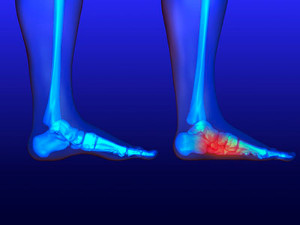 Many people have a foot condition that is referred to as flat feet. This term is used if the patient has extremely low arches or the arch doesn't exist at all. The purpose of the arch is to aid in balancing the weight of the body as it extends to the feet and legs. The foot will benefit if the arch is flexible and strong, which may help in maintaining balance on different types of surfaces. There are several common symptoms that many patients are aware of including pain that may affect the entire foot and ankle, swelling on the inside of the foot, and a stiff feeling that may be experienced in one or both feet. Possible causes for this condition to develop may originate from an inherited trait, an injury that may have occurred to the foot or ankle, or a medical condition such as arthritis. A podiatrist can perform a correct diagnosis to determine the severity of this ailment in addition to discussing proper treatment techniques.
Many people have a foot condition that is referred to as flat feet. This term is used if the patient has extremely low arches or the arch doesn't exist at all. The purpose of the arch is to aid in balancing the weight of the body as it extends to the feet and legs. The foot will benefit if the arch is flexible and strong, which may help in maintaining balance on different types of surfaces. There are several common symptoms that many patients are aware of including pain that may affect the entire foot and ankle, swelling on the inside of the foot, and a stiff feeling that may be experienced in one or both feet. Possible causes for this condition to develop may originate from an inherited trait, an injury that may have occurred to the foot or ankle, or a medical condition such as arthritis. A podiatrist can perform a correct diagnosis to determine the severity of this ailment in addition to discussing proper treatment techniques.
Flatfoot is a condition many people suffer from. If you have flat feet, contact Dr. Stephan J. LaPointe from Georgia Foot & Ankle Specialists . Our doctor will treat your foot and ankle needs.
What Are Flat Feet?
Flatfoot is a condition in which the arch of the foot is depressed and the sole of the foot is almost completely in contact with the ground. About 20-30% of the population generally has flat feet because their arches never formed during growth.
Conditions & Problems:
Having flat feet makes it difficult to run or walk because of the stress placed on the ankles.
Alignment – The general alignment of your legs can be disrupted, because the ankles move inward which can cause major discomfort.
Knees – If you have complications with your knees, flat feet can be a contributor to arthritis in that area.
Symptoms
Treatment
If you are experiencing pain and stress on the foot you may weaken the posterior tibial tendon, which runs around the inside of the ankle.
If you have any questions please feel free to contact our office located in Rome, GA . We offer the newest diagnostic and treatment technologies for all your foot and ankle needs.